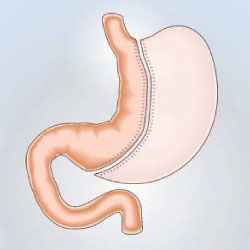Gastric Sleeve Surgery or Sleeve Gastrectomy

The gastric sleeve involves reducing the size of the stomach from a sac to a narrow tube. About 80 per cent of the stomach is removed. It is performed laparoscopically (using minimally invasive keyhole surgery).
Weight is lost because the patient feels fuller earlier after eating, largely due to the smaller size of the stomach. The procedure also reduces some appetite stimulating hormones produced by the stomach. Apart from this effect, the stomach digests calories and nutrients in an almost normal way.
Pros of gastric sleeve surgery
- Removes the part of the stomach that produces the hunger hormone (ghrelin)
- By avoiding intestinal bypass, there is less chance of intestinal blockage or vitamin deficiency
- Good “first stage” procedure for very big patients (>160kg or MBI >55kg/m2)
Cons of gastric sleeve surgery
- Potential for inadequate weight loss because no intestinal bypass is done
- Bigger patients may need to have a second stage procedure later
- Soft calories from food like ice cream can be absorbed and may slow weight loss
- Staple line leaks can occur
- Not reversible, but can be converted to a gastric bypass if necessary
Gastric sleeve surgery is explained in more detail in our patient information booklet, available for downloading
Surgery can dramatically improve quality of life and improve medical conditions associated with obesity.
Perioperative Safety in the Longitudinal Assessment of Bariatric Surgery
New England Journal of Medicine 2009;361:445-54.
Quality of Life Outcomes of Bariatric Surgery: A Systematic Review.
Obesity Surgery2016 Feb; 26(2): 395-409
